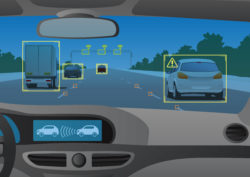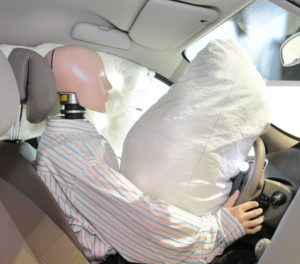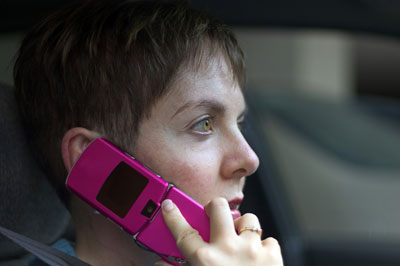Car Accident Prevention
Even if you have done everything in your power to maintain your vehicle, drive safely, and protect passengers from harm, it is not always possible to prevent death or serious injury from an unexpected vehicle crash.
The attorneys at Searcy Denney know all too well the devastation that can be caused by a hidden design defect, a drunk or distracted driver, a poorly-maintained road, or a tractor trailer out of control. We stand ready to share with you our more than 45 years of experience helping victims of vehicle accidents. For us, no case is too complex, and every case matters.
New Technology, Regulatory Enforcement Reduce Car Crash Risk
 A major advancement in preventing car crash fatalities and injuries was the seat belt, first required in 1968 by the federal government to be installed in passenger cars. The Center for Disease Control and Prevention (CDC) says that seat belts are estimated to have saved 12,802 lives in 2014, and to have reduced serious crash-related injuries and deaths by about half.
A major advancement in preventing car crash fatalities and injuries was the seat belt, first required in 1968 by the federal government to be installed in passenger cars. The Center for Disease Control and Prevention (CDC) says that seat belts are estimated to have saved 12,802 lives in 2014, and to have reduced serious crash-related injuries and deaths by about half.
The National Highway Traffic Safety Administration (NHTSA) credits other safety features, as well, with preventing thousands of deaths and hundreds of thousands of injuries.
- An estimated 42,282 lives have been saved by frontal air bags from 1987 through 2014.
- About 1,500 lives are saved each year by motorcycle helmets.
- Electronic stability control (ESC), required in all cars made after 2012, decreased rollovers in passenger cars by 59.5% and by as much as 74% in SUVs, vans and pickup trucks.
- Hundreds of lives of 18-, 19- and 20-year-old drivers are spared each year by drinking laws that set the minimum legal drinking age at 21.
In recent vehicle safety developments:
- In May 2016, NHTSA expanded its air bag inflator recall to include about 35 million more airbags manufactured by Takata. This brings the total recall number to about 63 million. At least eleven deaths have been attributed to these defective airbags, which can explode and send small metal fragments into the vehicle.
- NHTSA announced in June 2016 new federal consumer protection measures covering recalled rental cars. A new law requires that car rental agencies with more than 35 vehicles must repair all open safety defects before renting cars to customers.
- In an unusual move, NHTSA head Mark Rosekind suggested at a driver safety conference at Harvard that Americans should use the phrase “car crash” instead of “auto accident” in discussions of vehicle crashes. Some grassroots safety advocates and government leaders say that “accident” implies that an incident was no one’s fault and trivializes the more than 30,000 fatalities each year, when, in fact, most “crashes” are the result of drivers’ bad behavior.
- Looking to the future, some legislators and auto company executives are turning their attention to the dangers of self-driving vehicles. Concerns have been intensified in the wake of a Tesla crash in May 2016 the car’s human driver was killed while relying on sensors and computer software. One proposal calls for a national testing center, operated by the U.S. Department of Transportation (DOT), where carmakers could share technology and test reliability and safety features.
Even with technological advances and rigorous enforcement of safety laws, accidents happen. If an auto accident happens to you or your family, the Florida car crash attorneys at Searcy Denney are available to discuss your options, gather the evidence to make your case, and fight for you at the negotiating table or in the courtroom.
Vehicle Safety Rule Is “Buckle Up,” But Not Everyone Does

In 2014, an estimated 80 percent of drivers and passengers were killed when ejected from their vehicles in car crashes. Statistics prove, and experts agree, that wearing a seat belt can make the difference between life and death.
The NHTSA reports that, in 2015, seat belt use reached 88.5%. This has been accompanied by a gradual decline in the number of people killed in car crashes who were not wearing seat belts.
- Drivers and passengers in the Western United States were more likely to be wearing seat belts than in other regions.
- Rear-seat passengers were less likely than front-seat passengers to belt up.
- Seat belt use was higher in states with strong enforcement laws, where cars could be pulled over only because occupants were not wearing seat belts.
- Significant increases in seat belt use were noted for occupants of passenger cars (from 88.1% in 2014 to 90.3% in 2015) and in pickup trucks (from 77.2% in 2014 to 80.8% in 2015).
In 1986, nearly 20 years after seat belts were introduced, a national Safety Belt Law was passed requiring states to enact seat belt laws. States responded by passing two types of laws:
- Primary, which means if a law enforcement officer observes a driver or passenger who is not wearing a seat belt, the officer may pull the vehicle over and issue a ticket; and
- Secondary, meaning that an officer may stop a vehicle and issue a ticket for a seat belt violation only after the driver has been stopped and cited for another infraction.
As of 2015, 34 states plus the District of Columbia have primary seat belt laws. Secondary seat belt laws are in effect in 15 states, many of which have initiated primary enforcement for younger drivers and passengers. New Hampshire is the only state that does not require adults to wear seat belts, but it does require children under 18 to buckle up.
Details of state laws can vary widely. Florida law, for example, requires all front seat occupants – driver and passengers – to buckle up, but not back seat adult passengers. Children between ages six and 17 must wear seat belts whether sitting in the front or back seats. The driver is responsible for compliance, and each county imposes a set fine for violations. Despite evidence that fines increase compliance, Florida’s compliance level remains below the national average.
The Florida auto accident lawyers at Searcy Denney urge everyone to buckle up, whether a driver or passenger. But even though seat belts can save lives and prevent injuries, accidents happen. With more than 45 years’ experience representing families involved in auto accidents, our law firm will fight for your rights if a loved one is killed or you are injured in a car crash.
All 50 States Have Regulations to Save Children’s Lives
The NHTSA reports that in 2014, the lives of an estimated 252 children under five years old were saved by child car seat restraints.
- In all 50 seats, child safety seats are required for infants and toddlers.
- In 48 states and the District of Columbia, booster seats are required for children too large for infant seats, yet too small for adult seat belts.
- Many states require children to be seated in the back seat, not the front passenger seat.
- Five states – California, Florida, Louisiana, New Jersey, and New York – mandate seat belts on school buses.
- Fines for seat belt violations vary from $10 to $500, and some states assess points against the driver’s license.
The Florida Legislature in January 2015 passed new laws governing child car seats and safety restraints.
- Children three years old and younger must use a separate car seat or the vehicle’s built in car seat.
- Children four through five years old must sit in either a separate car seat, a built-in child seat, or a seat belt, depending upon the child’s height and weight.
- Children six through 17 years old must be in a seatbelt.
A new iPhone, iPad and Android app announced by the National Highway Traffic Safety Administration (NHTSA) in 2013 provides real-time vehicle safety information for consumers, including how to find help in installing children’s car seats. The app, which can be downloaded from Apple’s iTunes store, also includes:
- 5-star safety ratings of various makes and models of cars;
- Where to file vehicle safety complaints;
- How to find recall information;
- How to subscribe to automatic notices about car recalls.
For the Florida auto accident attorneys at Searcy Denney, many of whom are parents or grandparents, protecting our children is a top priority. That’s just one reason why our law firm helps so many families suffering the tragedy of an auto accident. If you are one of those families, we’re just a call away for a free, confidential conversation that can help you find your way through this difficult time.
Airbags Cut Crash Deaths But Can Pose Dangers
 The combination of seat belts and airbags has proved to be the most effective accident protection for drivers and passengers.
The combination of seat belts and airbags has proved to be the most effective accident protection for drivers and passengers.
Airbags were first introduced in passenger cars in the 1970s, but these early models had significant design flaws that were responsible for fatalities caused solely by the airbags, especially among shorter-than-average or underweight occupants. Improved versions were re-introduced, and by 1991, driver-seat front airbags were mandatory. In 1998, both driver and passenger-seat front airbags were required by federal law in all passenger cars; in 1999, they were required in light trucks and vans, as well.
Frontal airbags saved an estimated 2,396 lives in 2014, and studies by the Insurance Institute for Highway Safety indicate that side airbags provide even more protection.
- Side airbags with head protection reduce a driver’s risk of death by 37 percent and an SUV driver’s risk by 52 percent.
- Side airbags that protect just the torso reduce fatalities by 26 percent for passenger car drivers.
To enhance the proven effectiveness of airbags, organizations such as the Governors Highway Safety Association continue to urge additional testing using crash dummies of various sizes, and to encourage auto manufacturers to offer advanced airbag technology that protects people of all sizes.
While side-impact airbags are not yet standard equipment, they are being installed in more and more passenger cars. Currently, there are three types of side-impact airbags (SABs):
- Chest SABs, which are installed in the door or side of the seat to lesson impact on the chest;
- Head SABs, installed in a car’s roof above side windows to cushion the head in a side-impact crash; and
- Combination SABs, a larger airbag that combines both the chest and head versions.
The NHTSA estimates that early airbag models caused more than 290 deaths between 1990 and 2008, but technology has made airbags safer. In 2001, NHTSA modified safety standards to require that vehicles made after 2007 have airbags with sensors to detect a small driver or passenger or a child in a safety seat, in which cases airbags would be deployed with less force.
The Insurance Institute for Highway Safety offers some additional recommendations for preventing airbag injuries:
- All vehicle occupants should be belted and sitting upright, with feet on the floor. Arms and legs should not rest against an airbag, which could cause accidental deployment.
- Drivers should sit with their chests at least 10 inches away from the center of the steering wheel.
- Pregnant women who cannot get their abdomens far enough from the steering wheel may risk fetal injury in an accident and should avoid driving when possible.
- Infants and children minimize airbag risks if they are placed in an approved child car seat. Rear seats are the safest.
Several airbag innovations appear promising for greater protection in case of a vehicle crash. Inflatable shoulder seat belts reduce risk for adults and for children in booster seats or safety belts alone. Volvo has developed a hood airbag that is designed to protect pedestrians, so that when collision with a pedestrian is detected, an airbag inflates from under the hood to cover the windshield and other areas that pedestrians are most likely to hit.
If you or a family member has been injured by a defective airbag or an unexpected airbag deployment, a free, confidential consultation with one of the experienced auto accident attorneys can explain what recourse you may have and help you seek justice for your losses.
Distracted Driving Laws Save Drivers, Passengers, Pedestrians
Distracted driving can mean anything from eating or drinking to applying makeup to using a navigation system. But sending and reading text messages while driving has become the number one cause of distracted driving deaths and injuries. The NHTSA reports that the percentage of drivers texting or manipulating hand-held devices has increased from 1.7% in 2013 to 2.2% in 2014, with drivers between 16 and 24 years old leading the pack.
A US Department of Transportation (DOT) Distracted Driving Summit in 2009 became the catalyst for a national campaign to decrease traffic deaths and injuries associated with distracted driving, and to educate the public about the dangers of distractions such as texting and cell phone use on our roads and highways.
By 2011, texting and cell phone use by drivers had become so prevalent – and so dangerous – that many state legislatures and some municipal governments passed restrictions or outright bans. Between 2011 and 2014, smart phone ownership in the U.S. grew from 52% to 80%, increasing the potential risks for drivers, passengers, and pedestrians.
Two new distracted driving risks that have the potential for widespread accidents are Snapchat, an interactive communication smartphone app, and Pokemon Go, a game where drivers search real locations in their area to capture virtual Pokemon characters.
Snapchat enables drivers to send their friends photos and videos that are destroyed shortly after they are received, and also can include a messaging and video chat app. The Pokemon Go game, which can be downloaded for free, guides players via a GPS map and displays which Pokemon figures are likely to pop up in nearby locations.
NHTSA data indicate that distracted driving killed 3,179 people in 2014 and injured 431,000 more. The figure may be even higher, NHTSA warns, because data collection is uncoordinated among the states and many distracted driving accidents go unreported.
- Ten percent of all drivers between 15 and 19 years old who were involved in fatal crashes were distracted at the time of the accident.
- Drivers in their 20s constitute 27% of distracted drivers in fatal accidents overall, and 38% of distracted drivers who were using cell phones at the time of the crash.
- In a survey by the Pew Research Center, a third of respondents admitted to texting while driving.
According to the most recent information from the Insurance Institute for Highway Safety the following texting bans and cell phone restrictions have been adopted in the United States.
Texting Bans
- 46 states plus the District of Columbia, Puerto Rico, Guam and the U.S. Virgin Islands ban all drivers from texting.
- 2 states ban novice or teen drivers from texting.
- 3 states prohibit school bus drivers from texting.
As of October 1, 2013, Florida has prohibited drivers of all ages from texting while driving. But enforcement is secondary, meaning that a driver must be stopped for another violation rather than for texting itself.
Cell Phone Restrictions
Increases in fatalities and injuries, combined with increases in smart phone ownership, have prompted states to consider restrictions on cell phone use while driving, including outright bans.
- While no states have banned all cell phone use for all drivers, 14 states, the District of Columbia, Puerto Rico, Guam and the U.S. Virgin Islands bar drivers of all ages from talking on hand-held cell phones while driving.
- Novice drivers in 37 states and the District of Columbia are prohibited from any cell phone use while driving.
- School bus drivers in 20 states and the District of Columbia are banned from using cell phones when there are passengers in the bus.
A first-of-its kind advocacy group called FocusDriven was formed in January 2010 as a result of collaboration among families of distracted driving victims, law enforcement, researchers, public officials and existing safety advocacy organizations such as the National Safety Council. In addition, the NHTSA has launched Distraction.gov, a website loaded with statistical reports, demonstration projects, and other research, plus educational materials such as videos and public service announcements.
In Any Kind of Vehicle Accident, We Have the Experience to Help
Our Florida accident attorneys are deeply committed to helping families that have suffered a death or injuries in a catastrophic auto accident. Over more than 45 years, we have achieved substantial settlements and verdicts on behalf of our clients. Our convenient, fully-staffed offices in West Palm Beach and Tallahassee welcome you for a free, confidential consultation with one of our lawyers.
Please complete our Contact Form or call us at 1-800-780-8607 to schedule an appointment.
Share This


